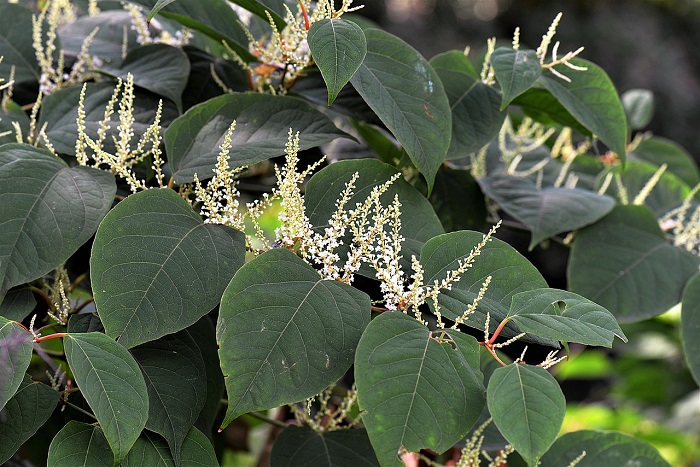To control Japanese Knotweed, you need to break out your strategic skills. Start with a chemical herbicide treatment, choosing fast-working options like glyphosate. Don’t shy away from physical removal – dig deep and discard carefully.
You’ve also got biological control on your side, utilizing insects or fungi like Psyllid and Mycosphaerella leaf spot fungus. Round it out by installing a root barrier and altering your landscape to discourage growth.
Implementing these methods should help you conquer this invasive species, and there are further details that will boost your battle plan.
Chemical Herbicide Treatment
Harnessing the power of chemical herbicides is one of the most effective ways to combat the spread of Japanese Knotweed. This method isn’t only cost-effective but produces quick results. You’ll want to use a systemic herbicide, one that’s absorbed by the plant and then transported throughout its system, killing it from the inside out.
The active ingredient most commonly used is glyphosate, a non-selective herbicide. This means it’ll harm any plant it comes into contact with, so you must be cautious during application. You’ll typically apply the herbicide to the leaves during the growing season when the plant is actively taking in nutrients.
But don’t expect immediate results. The herbicide needs time to penetrate the plant thoroughly. Usually, it’ll take several weeks for the knotweed to die. However, it’s crucial to monitor the plant for regrowth. Knotweed is notoriously resilient, and a single surviving piece can lead to a new infestation.
Remember, safety first. Always use protective clothing and follow instructions on the herbicide label. It’s also crucial to contemplate the environmental impact, especially near water sources or wildlife.
If you’re persistent and patient, chemical herbicide treatment can be an effective weapon against Japanese Knotweed.
Physical Removal Tactics
In addition to chemical herbicides, you’ve got the option of physically removing Japanese Knotweed, a hands-on approach that can be quite effective when done correctly. This method involves excavation or manual digging to remove the underground rhizomes, the plant’s crucial parts that enable its rapid spread.
It’s crucial to dig out as much of the rhizome network as possible, as even small sections left behind can regrow into a new plant.
This tactic requires consistent effort and vigilance, as you’ll need to monitor the area for potential regrowth and remove any new shoots promptly. You should also dispose of the removed knotweed properly, as improper disposal can lead to further plant spread. Incineration or disposal at a licensed facility is recommended.
While this method can be labor-intensive, it’s a preferable option if you want to avoid using chemicals, especially in sensitive areas. However, remember that physical removal alone often isn’t enough to eradicate Japanese Knotweed due to its persistent nature fully. It’s usually more effective when combined with other control methods.
Utilizing Biological Control
Another method you might consider for Japanese Knotweed control is utilizing biological controls. This approach requires the introduction of natural enemies, such as insects or fungi, which can curb the growth of this stubborn weed. It’s a more ecological approach, often preferred for its minimal impact on surrounding flora and fauna.
One of the most promising biocontrol agents is the psyllid, Aphalara itadori. Originating from Japan, this tiny insect feeds on Japanese Knotweed, slowing its growth and potentially reducing its density.
However, it’s not a quick fix. The psyllid takes time to establish and it might be several years before a noticeable impact occurs.
Another potential ally in your battle against Knotweed is the Mycosphaerella leaf spot fungus. This fungus, native to Japan, causes defoliation and reduces the plant’s ability to photosynthesize, thereby weakening it over time.
Barrier and Landscape Modification
You can also control Japanese Knotweed by modifying your landscape and creating physical barriers to halt its spread. This method is a practical and effective way to combat this invasive species.
Firstly, you could consider installing a root barrier. This should be a tough, impermeable material that’s buried deep into the ground, generally about 2-3 meters, to prevent the plant’s roots from spreading. It’s important to guarantee the barrier extends above ground level to stop the Knotweed from simply growing over it.
Secondly, altering the landscape can help. Since Knotweed thrives in disturbed soil, reducing soil disturbance and compaction in your yard can deter its growth. You might also create a slope or a mound, as these plants struggle to dominate such areas.
Professional Knotweed Services
If you’re feeling overwhelmed by your knotweed problem, don’t worry – professional knotweed services are available to help. These services are provided by experts who’ve extensive knowledge and experience in dealing with this invasive plant. They understand its life cycle, growth habits, and the most effective eradication methods.
Hiring a professional knotweed service saves you time and ensures the knotweed is completely eliminated, preventing its return.
They’ll use specialized equipment and potent herbicides that aren’t usually available to the general public. Additionally, these professionals are trained to apply these treatments safely, minimizing potential environmental harm.
Conclusion
Now you’re informed on how to combat Japanese knotweed. Utilizing chemical herbicides can be effective, or you might choose physical extraction.
Biological control provides a natural alternative, and implementing barriers and modifying your landscape can aid in thwarting future incursions.
While it’s a challenging endeavor, you’re now equipped with the necessary strategies to win back your garden. Consistency is crucial in this battle. Ensure that this invasive species doesn’t overpower your efforts.
Best of luck from your Japanese knotweed removal company in Scotland!




